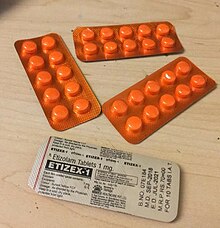 | |
 | |
| Clinical data | |
|---|---|
| Trade names | Etizest, Etilaam, Etizex, Depas, Sedekopan, Pasaden |
| Dependence liability | Moderate |
| Routes of administration | Oral, sublingual, rectal |
| ATC code | |
| Legal status | |
| Legal status |
|
| Pharmacokinetic data | |
| Bioavailability | 93% |
| Metabolism | Hepatic |
| Elimination half-life | 3.4 hours[2][3] (main metabolite is 8.2 hours)[4] |
| Duration of action | 5-7 hours |
| Excretion | Kidney |
| Identifiers | |
| |
| CAS Number | |
| PubChem CID | |
| ChemSpider | |
| UNII | |
| KEGG | |
| ChEMBL | |
| CompTox Dashboard (EPA) | |
| ECHA InfoCard | 100.188.773 |
| Chemical and physical data | |
| Formula | C17H15ClN4S |
| Molar mass | 342.85 g·mol−1 |
| 3D model (JSmol) | |
| |
| |
| | |


Etizolam (marketed under numerous brand names) is a thienodiazepine derivative[5] which is a benzodiazepine analog.[6] The etizolam molecule differs from a benzodiazepine in that the benzene ring has been replaced by a thiophene ring and triazole ring has been fused, making the drug a thienotriazolodiazepine.[7][8]
Although a thienodiazepine, etizolam is clinically regarded as a benzodiazepine because of its mode of action via the benzodiazepine receptor and directly targeting GABAA allosteric modulator receptors.[5]
It possesses anxiolytic, amnesic, anticonvulsant, hypnotic, sedative and skeletal muscle relaxant properties.[9]
It was patented in 1972[10] and approved for medical use[where?] in 1983.[11]
As of April 2021, the export of etizolam has been banned in India.[12]
- ^ Anvisa (2023-03-31). "RDC Nº 784 - Listas de Substâncias Entorpecentes, Psicotrópicas, Precursoras e Outras sob Controle Especial" [Collegiate Board Resolution No. 784 - Lists of Narcotic, Psychotropic, Precursor, and Other Substances under Special Control] (in Brazilian Portuguese). Diário Oficial da União (published 2023-04-04). Archived from the original on 2023-08-03. Retrieved 2023-08-16.
- ^ "Etizolam". www.drugbank.ca. Retrieved 2020-09-03.
- ^ "Drug & Chemical Evaluation - Etizolam" (PDF). U.S. Drug Enforcement Administration. U.S. Department of Justice. March 2020. Archived (PDF) from the original on 2020-09-03.
- ^ Fracasso C, Confalonieri S, Garattini S, Caccia S (1991-02-01). "Single and multiple dose pharmacokinetics of etizolam in healthy subjects". European Journal of Clinical Pharmacology. 40 (2): 181–185. doi:10.1007/BF00280074. PMID 2065698. S2CID 10176681.
- ^ a b Sanna E, Pau D, Tuveri F, Massa F, Maciocco E, Acquas C, et al. (February 1999). "Molecular and neurochemical evaluation of the effects of etizolam on GABAA receptors under normal and stress conditions". Arzneimittel-Forschung. 49 (2): 88–95. doi:10.1055/s-0031-1300366. PMID 10083975. S2CID 19732765.
- ^ Manchester KR, Maskell PD, Waters L (March 2018). "Experimental versus theoretical log D7.4, pKa and plasma protein binding values for benzodiazepines appearing as new psychoactive substances" (PDF). Drug Testing and Analysis. 10 (8): 1258–1269. doi:10.1002/dta.2387. PMID 29582576. S2CID 31098917.
- ^ Niwa T, Shiraga T, Ishii I, Kagayama A, Takagi A (September 2005). "Contribution of human hepatic cytochrome p450 isoforms to the metabolism of psychotropic drugs". Biological & Pharmaceutical Bulletin. 28 (9): 1711–6. doi:10.1248/bpb.28.1711. PMID 16141545.
- ^ Catabay A, Taniguchi M, Jinno K, Pesek JJ, Williamsen E (1 March 1998). "Separation of 1,4-Benzodiazepines and Analogues Using Cholesteryl-10-Undecenoate Bonded Phase in Microcolumn Liquid Chromatography". Journal of Chromatographic Science. 36 (3): 111–118. doi:10.1093/chromsci/36.3.111.
- ^ Mandrioli R, Mercolini L, Raggi MA (October 2008). "Benzodiazepine metabolism: an analytical perspective". Current Drug Metabolism. 9 (8): 827–844. doi:10.2174/138920008786049258. PMID 18855614.
- ^ US 3904641, "Triazolothienodiazepine compounds"
- ^ Fischer J, Ganellin CR (2006). Analogue-based Drug Discovery. John Wiley & Sons. p. 536. ISBN 9783527607495.
- ^ "EGazette Home". Archived from the original on 2022-03-14. Retrieved 2021-05-14.